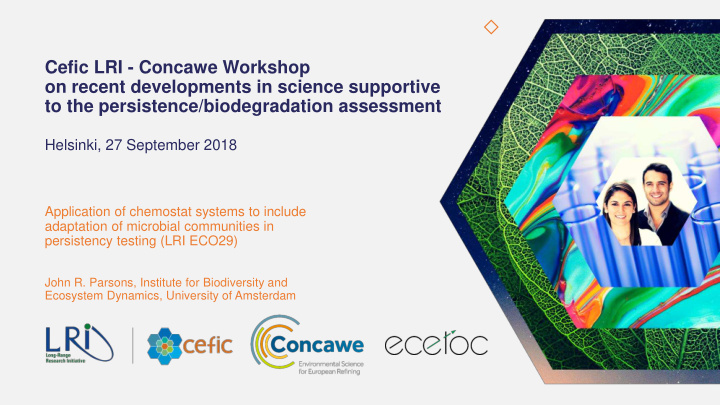



Cefic LRI - Concawe Workshop on recent developments in science supportive to the persistence/biodegradation assessment Helsinki, 27 September 2018 Application of chemostat systems to include adaptation of microbial communities in persistency testing (LRI ECO29) John R. Parsons, Institute for Biodiversity and Ecosystem Dynamics, University of Amsterdam
In Influence of of adaptation on bio iodegradation GLDA Atrazine 100 90 80 70 % Theoretical CO 2 60 1 mth 5 mths 50 7 mths 8 mths 40 16 mths Positive 30 Control 20 10 0 0 5 10 15 20 25 Time in days Biodegradation as a function of time following initial shipment Comparison of the atrazine removal rates with (days 43 and of product with L-GLDA 105) or without the addition of carbon and nitrogen sources Itrich et al. (2015) Environ. Sci. Technol. 49, 13314-13321 . (day 274). Zhou et al. (2017) Environ. Sci. Pollut. Res. 24, 22152-22157. • Current stringent protocols (such as OECE 310) underestimate biodegradability. 2 • Will incorrectly identify persistent chemicals if used for persistency determination
Exp xperimental approach Biodegradation testing in Activated sludge batch CO 2 production LC-MS/MS Chemostat Biodegradation testing in 2 1 batch Community profiling 1. Long term exposure of the microbial community to test chemicals (4- chloroaniline, carbamazepine, metformin, N-methylpiperazine) in chemostat at 1.5 mg/L with 40 mg/L acetate 2. Exposed cultures used in biodegradation tests according to the OECD 310 guideline 3
Bio iodegradation of metformin in in OECD 310 Biodegradation of metformin Metformin Transformation Guanylurea Production of guanylurea Guanylurea is eliminated from OECD 310 tests 4 - new transformation product? CO 2 production?
Bio iodegradation of N-methylp lpip iperazine in in OECD 310 120 Primary biodegradation (LC- MS/MS) 100 Inoculum from chemostat after 9 80 months 60 CO 2 production 40 20 Inoculum from activated sludge (CO 2 production) 0 -20 LC-MS/MS CO2 production -40 CO2 production Activated sludge -60 0 5 10 15 20 25 30 60% mineralisation of N-methylpiperazine by activated sludge exposed for 9 months 5
Impact of orig Im igin of in inocula on bio iodegradation Metformin WWTP Amsterdam Amstelveen Utrecht Bennekom Eindhoven Guanylurea Biodegradability testing of 4- chloroaniline, carbamazepine, diclofenac, metformin, N- methylpiperazine OECD 310 guideline with and without pre-exposure (6 d at 20 mg/L) 6
Conclusions • The biodegradation capacity of microbial communities increases due to adaptation to pollutants during long term exposure, resulting in faster biodegradation of initially persistent chemicals • Adaptation of microbial communities can be achieved under defined and realistic conditions in chemostat systems • Taking adaptation into account in testing protocols will result in more realistic and reproducible assessment of biodegradability and persistency • Implementation in practical protocols for regulatory testing? 7
Thank you Baptiste Poursat 1,2 ,Martin Braster 2 , Rick Helmus 1 , Pim de Voogt 1 , Rob van Spanning 2 1 : Institute for Biodiversity and Ecosystem Dynamics, University of Amsterdam, Science Park 904, 1098 XH Amsterdam, The Netherlands. 2 : Department of Molecular Cell Biology , Vrije Universteit, de Boelelaan 1108, 1081 HZ Amsterdam, The Netherlands. CEFIC-LRI LRI SECRETARIAT - Tel + 32 2 676 73 68 – lri@cefic.be - www.cefic-lri.org
Recommend
More recommend